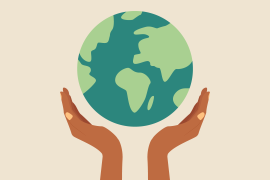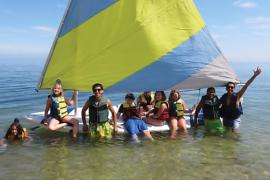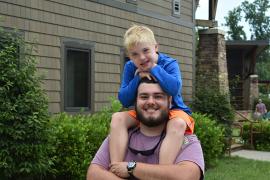“You get all those different kids at camp, but it wasn’t there. It didn’t affect them there. There was so much love in the air. They came together, bonding, making friends, doing things they can’t do at home, and that type of thing. Seemed like it never even came up.”
The “it” to which Cedric Randolph is referring is the shooting of Michael Brown by a police officer on August 9, 2014, and the after effects. Randolph is a camp counselor at Sherwood Forest, which serves youth from Ferguson, Missouri, and the St. Louis area. His younger brothers are from Ferguson and participate in leadership programs at Sherwood Forest.
Randolph described his view of Ferguson: “The police set you up and profile you, and the area has always been known to be like that. When I got home from camp that summer, I wasn’t even surprised that happened. That was the scary part to me.” He described later talking with his brothers after Officer Darren Wilson’s acquittal and the resulting protests: “We gotta watch what we’re doing, how we’re moving.”
But at camp, Randolph explained why “it” didn’t cause problems: “Just because of how the counselors did their jobs. They forgot they were paid because they were there for the kids. Any minor racial things boys brought up in the beginning of the session were squashed by counselors. It happened because of the type of love you get at camp. At home it’s different. There’s a difference between camp and home. At camp you’re experiencing different things together, being in a group.”
Sherwood Forest camp alum and parent of a current Sherwood Forest camper who is biracial, Michelle Maschmidt agreed. She said that camp should be about “learning teamwork and that everyone is the same person. Camp is about making everyone feel equal, learning that everyone needs to be treated the same, treating people how you want to be treated.” As a ten-year resident of Ferguson, Maschmidt shared, “The racial makeup of my daughter’s class is very mixed. That’s what I like and what I want for her. But when I tell people I live in Ferguson, they sound worried or fearful or judgmental.” Reflecting on her time as a camper, Maschmidt shared that racial issues weren’t “talked about when I was there, but talking to kids about it now is probably good.”
I talked with Randolph and Maschmidt because I wanted to know more about their perspectives on what it was like to live in a place and time severely rocked by racial injustice. As a white, educated, mostly privileged camp professional serving diverse populations, I knew enough to know there was much I didn’t know. As someone with a personal and lifelong commitment to ending injustice and oppression, I wanted to educate and challenge myself to take action to create interpersonal, societal, and systemic changes in the institution of camp.
What’s changing? Some consider the shooting of Michael Brown by a police officer to be a major spark in the modern day civil rights movement Black Lives Matter. Other communities facing recent race- related strife, such as Baltimore, Staten Island, and Chicago, are also homes for children and youth who attend summer camps. Many campers each summer come to our camps from communities plagued by racial violence, economic disparity, and injustice. How do camps address this? Or do we? Should we even try? This is a call to conversation for our camp community. The hope is that conversation will ultimately lead to change in the arena where we have power and passion: camp.
Cycles of Socialization
Since the early days of the camp movement, people have viewed camps as places to get away from real life, to be safe spaces, havens. But can we truly forget or ignore the social influences on our campers? Campers and staff come to camp with the influences of their life experiences. Their life experiences are affected by the identities with which they were born and those they take on through life. These identities are further influenced by how others perceive the identities — as good or as bad. And these perceptions come from socialization — what we are taught and what is reinforced by our families, friends, communities, and media about people, cultures, and behaviors.
Getting out of these cycles of socialization means recognizing that people are individuals but also members of social groups, and that these social groups are valued unequally in society. Those social groups that are valued more highly have greater access to a society’s resources. It also means acknowledging that social injustice is real, exists today, and results in unequal access to resources between groups of people (Sensoy & DiAngelo, 2012).
Camps are socializing agents too. There is much research-based evidence that camps can promote positive youth development for individuals, such as improved teamwork, increased self-efficacy, stronger sense of belonging, and personal growth. However, many camps serve mostly homogenous groups of youth in terms of race/ethnicity, region, religion, income level, etc. When we’re around people who think in the same way we do and have similar life experiences as we’ve had, we tend to be less open to the thinking and experiences of others.
Sherwood Forest Executive Director Mary Rogers said, “Because of their camp experiences, our kids get to have bigger lives. At camp they get to have experiences they’d never otherwise have because many of them are growing up in poverty. Our camp is a place where kids feel welcome and accepted. It is important for us to create a space at camp where kids get to talk about race and poverty and social justice. These are not easy conversations to have, but they are critical because the issues are real for our kids.”
Social Justice
If camps want to have conversations about prejudice, what should we do? How do we become aware of ourselves? How do we consider what we do to enact and reinforce oppressive attitudes and behaviors? How do camps make these attitudes worse? How can camps make them better? These are big topics. If we assume that camps should be aware of social issues outside and inside our gates, how do we begin to figure this out? One way to try to start answering these questions is by looking at the issues through the lens of social justice.
What is social justice? There is no one definition, but here are some different ways to think about it:
- Full and equal participation of all groups in society (Social Justice Training Institute — sjti.org).
- The view that everyone deserves equal economic, political, and social rights and opportunities (National Association of Social Workers — naswdc.org/pressroom/features/issue/peace.asp).
- The virtue that guides us in creating those organized human interactions we call institutions. In turn, social institutions, when justly organized, provide us with access to what is good for the person, both individually and in our associations with others. Social justice also imposes on each of us a personal responsibility to work with others to design and continually perfect our institutions as tools for personal and social development (Center for Economic and Social Justice — cesj.org/learn/definitions/defining-economic-justice-and-social-justice).
- A critical approach to social justice refers to specific theoretical perspectives that recognize that society is stratified (i.e., divided and unequal) in significant and far-reaching ways along social group lines that include race, class, gender, sexuality, and ability. Critical social justice recognizes inequality as deeply embedded in the fabric of society (i.e., as structural) and actively seeks to change this (Sensoy & DiAngelo, 2012).
- Social justice is both a process and a goal. The goal of social justice is full and equal participation of all groups in a society that is mutually shaped to meet their needs. Social justice includes a vision of society in which the distribution of resources is equitable and all members are physically and psychologically safe and secure. We envision a society in which individuals are both self-determining (able to develop their full capacities) and interdependent (capable of interacting democratically with others). Social justice involves social actors who have a sense of their own agency as well as a sense of social responsibility toward and with others, their society, and the broader world in which we live. These are conditions we wish not only for our own society, but also for every society in our interdependent global community (Adams, Bell, & Griffin, 2007).
A Discussion about Social Justice
Most discussions about social justice involve these six ideas:
- Equity involves providing opportunities and access to all programs so that every person can achieve their full potential. Equitable treatment involves acknowledging diversity, recognizing and celebrating our differences, and eliminating barriers that prevent the full participation of all people.
- Self-determination involves the freedom to live authentically and with dignity, and to pursue opportunities to develop. When self-determined, people take control of their future and decide how to address the issues facing them. Self-determination is the right to make one’s own choices and decisions, provided this does not threaten the rights and legitimate interests of others.
- Self-reflection involves considering privileges that are consequences of social hierarchies and power dynamics. Privilege is an arbitrary advantage or benefit enjoyed by an individual or a group based on prejudicial and/or discriminatory norms, attitudes, and practices that might not always be recognized. Reflecting on and recognizing these social norms helps to bring light to different power dynamics and privileges so organizations can start promoting justice and equity.
- Cultural humility is the “ability to maintain an interpersonal stance that is other-oriented (or open to the other) in relation to aspects of cultural identity that are most important to the person” (American Psychological Association, 2013). It involves a life-long commitment to self-evaluation and self-critique, a desire to fix power imbalances, and aspirations to develop partnerships with people and groups who advocate for others.
- Social responsibility involves using power not just to make things better for individuals, but to promote better conditions for marginalized and/or less powerful groups. Social responsibility comes from awareness of social injustice, recognizing that we all have power, and using that power (whether earned or unearned) to take action to help others.
- An ally is a person of one social identity group who stands up in support of members of another group and is typically a member of the dominant group standing beside member(s) of a targeted group, such as a man arguing for equal pay for women. Allyship is an active, consistent, and arduous practice of unlearning and re-evaluating, in which a person of privilege seeks to operate in solidarity with a marginalized group of people (Anti-oppression Network, 2016).
The Camp Community
In addition to the longstanding social justice efforts of many camps, some work is being done through the American Camp Association (ACA). At ACA’s National Conference in New Orleans, Louisiana, in 2015, Dr. Laurie Browne and I facilitated a session called “Beyond Diversity: A Discussion.” Participants shared dozens of camp-related examples of equity, self-determination, self-reflection, and social responsibility. Themes of the examples included identifying ways to be fair, acknowledging the need to be responsive to changing demographics of campers and families, creating safe environments, training staff, choosing language carefully, and many others.
In 2016 at ACA’s National Conference in Atlanta, Georgia, Dr. Browne and I again facilitated a session called “Beyond Diversity: Stories from the Field,” which featured four “storytellers” who talked about their approaches to being “barrier-free,” supporting transgender campers, documenting racism, and supporting campers on scholarships. The purpose of these sessions was to increase awareness of how camps promote social justice, increase knowledge of strategies and opportunities, and inspire others to implement new strategies to promote social justice at camp.
Through the thoughtful and impassioned discussions during and after these sessions, it became apparent that camps are deeply motivated and interested to talk more about “it.” Conversations about social justice are already happening in camps, and have been for decades.
To further build opportunities for conversations, Camping Magazine will run a series of social justice articles over the next six issues. The series is a call to conversation, both at individual camps and as an industry. As we look at issues related to social justice, we elevate the process and dialogue in this work rather than focusing on outcomes and how-to’s. We celebrate what camps are doing rather than criticizing camps for what they’re not doing. We focus on many dimensions of diversity (not only race and ethnicity), recognizing that it comes in many forms.
The series will include stories from individual camps, stories shared through interviews, and strategies specific to staff training and camper programming. You will hear from many camp professionals having conversations about social justice and working on becoming aware and using their knowledge and power to end the cycle of socialization and start the cycle of liberation. This series is a call to action for our camp community to engage with these ideas, to become uncomfortable, to grow in awareness and empathetic actions, and to use camp as a liberating force for good.
Mary Rogers put things in perspective: “Ultimately, in order to interrupt racism and poverty, we need systemic change that creates more equity and inclusion in education and opportunity for all. Camp itself isn’t systemic change, if for no other reason than the fact we can’t serve all the kids who need us. But for those kids who do get to grow up with us, we know what we do is fundamentally changing the course of their lives for the better. And I believe that in the collective work of camp that is real and authentic for the kids we serve, we are planting the seeds of a brighter future for everyone.”
Here’s to more conversations about “it.”
Special thanks to Dr. Laurie Browne.
Ann Gillard, PhD, has worked in camps for over 20 years, including as a day and resident camp counselor, camp director, researcher, and evaluator. Ann is currently the chair of ACA’s Committee for the Advancement of Research and Evaluation (CARE). She is grateful for all of the teachers in her life. Contact Ann at [email protected].
References
Adams, M., Bell, L.A., & Griffin, P. (2007). Teaching for diversity and social justice, 2nd Edition. New York, NY: Routledge.
American Psychological Association. (2013). Reflections on cultural humility. Retrieved from apa.org/pi/families/resources/newsletter/2013/08/cultural-humility.aspx
The Anti-oppression Network. (2016). Allyship. Retrieved from https://theantioppressionnetwork.wordpress.com/allyship
Sensoy, O. & DiAngelo, R. (2012). Is everyone really equal? An introduction to key concepts in social justice education. New York, NY: Teachers College Press.
Resources for Further Reading
- Readings for Diversity and Social Justice, 3rd Edition (2013) by Maurianne Adams (Editor), Warren Blumenfeld (Editor), Carmelita Castaneda (Editor), Heather W. Hackman (Editor), Madeline L. Peters (Editor), Ximena Zuniga (Editor)
- Teaching for Diversity and Social Justice, 3rd Edition (2016) by Maurianne Adams (Editor), Lee Anne Bell (Editor), and Pat Griffin (Editor)
- Is Everyone Really Equal? An Introduction to Key Concepts in Social Justice Education (2012) by Ozlem Sensoy and Robin DiAngelo
- Why Are All the Black Kids Sitting Together in the Cafeteria: And Other Conversations About Race 5th Anniversary, Revised Edition (2003) by Beverly Daniel Tatum
- Camping Magazine articles:
- “Attracting Diverse Staff and Campers,” by Garrett Colgan-Snyder (September/October 2011)
- “Camp Diversity: A Call to Action” (March/April 2013)
- “The Inclusion Audit: Evaluating Your Camp’s Efforts to Include Diverse Populations,” by Maureen Kelly and Lisa Maurer (March/April 1999)
- “Serving Diverse Populations: A Profile of Three Camps” (November/December 2010)
- “Embracing the Larger Culture,” by Kevin Gordon (March/April 2009)
Originally published in the 2016 September/October issue of Camping Magazine.



